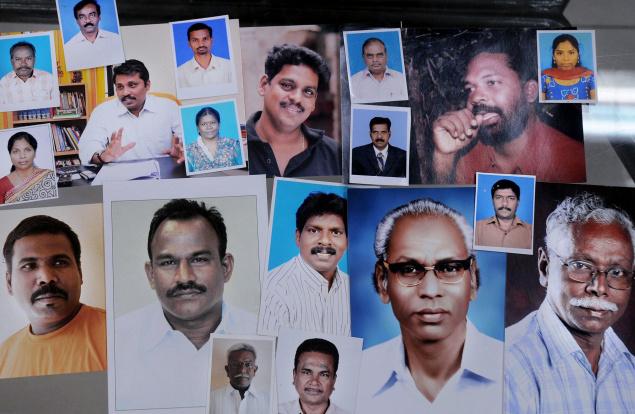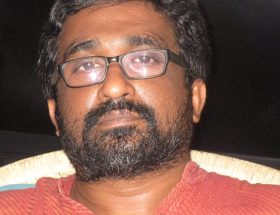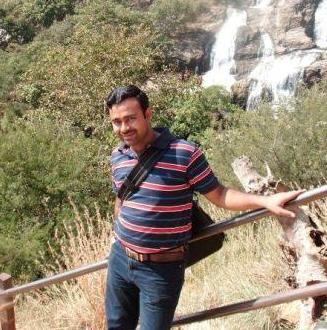Comments on Oxford India Anthology of Tamil Dalit Writing (Part II)
Continued from here.
P. Dayanandan
(Paper presented on 10th April, 2012 on the occasion of the release of the Oxford India Anthology of Tamil Dalit Writing)

• In this Anthology M. C. Rajah makes reference to the claim that ‘disabilities of ‘untouchables’ spring from deep-rooted social prejudices…’ (p.225). But then he is writing in English, and it is not any translation of a Tamil word. (By the way, in this 175th year of Madras Christian College we may want to recall that M.C. Rajah, and another great leader recalled by Anbu Ponnoviam in this Anthology – P. M. Maduraipillai – were old students of MCC. But you may not find their names in the list that is used to boast of great alumni of the College, call it prejudice or elitism!).
• Prejudice is the biggest problem! For many centuries millions of Dalits have suffered because of prejudice. As Raj Gowthaman has pointed out in his path-breaking early works there was prejudice against groups such as ilijanan, keezhpirapan, adiyor, kadaisiyar, pinnor, and pulayas even during Sangam period. Please tell me what is the most suitable word in Tamil that translates the term, prejudice? Looks like Tamils refused to acknowledge the very existence of prejudice. A young Tamil lecturer tells me that he never heard of some words that the MU English-Tamil Dictionary offers as Tamil equivalent for prejudice – murchayvu, murkol, thappennam, kedu, theengu, ooru, izhappu, pollangu, and ethircharbu.
• How do you fight prejudice? We are familiar with the oppressors blaming the Dalits for their present condition, both because of what they are supposed to have been in the previous birth and for what they are not doing right in this birth. An uncle of my wife lived for 30 years among the Dalits of Japan, known as Buraku-min. Grier found that: ‘Society in general thinks that the problem is in the Buraku and that we must become active to change the ‘dreadful’ conditions of the Buraku-min’. The mentality was to project the outcaste as the problem and that something must be done to remedy their deplorable situation and alleviate the injustice done to them. He said: ‘But this kind of thinking is totally backwards. The root of the problem is the prejudice of society in general, a prejudice which is a dreadful disease…we all have it, either consciously or unconsciously…I have it‘. Are the Dalits polluted? Grier would say: ‘Those who discriminate are polluted, not those who are discriminated against. The discriminators are the problem; they are the ones in need of liberation, salvation, and cleansing‘. Unfortunately, as Eleanor Zelliot has pointed out, no liberation theology has yet emerged in Hinduism. Perhaps this is what Ravi and Azhagarasan are referring to as qualitative change in their introduction. They say: ‘Unless a qualitative change takes place among the Hindus, there cannot be a quantitative change in the violence they perpetrate’.
Identity – A red herring
A theme that runs throughout this book, irrespective of the nature of the narrative, is identity.
Stalin Rajangam has an article in the Anthology that tells us how the Dalit search for identity has jolted and prompted non-Dalits to look for identities. Identity is truly a crisis in India, thanks to the caste system. It affects all the 50,000 or more endogamous groups, irrespective of the position in caste hierarchy. But it affects Dalits and others at the bottom the most. Who am I? My grandparents from Sriperumbudur area spoke Telugu and therefore my cousin tells me we are Reddiars. But my father settled that identity once and for all when he said that they spoke Telugu because they worked as agricultural laborers for the Telugu-speaking landlords! Should I believe the origin myths collected by Edgar Thurston or Robert Deliege and smugly settle down for a lineage from an elder brother of a brahmin duo? (When God asked one to bury the dead cow, he said that his thambi pappan – younger brother will take care of it – and that’s how the paraiyan became the older brother of a pappan). Or am I to believe Iyothee Thass Pandithar and Ravikumar and Azhagarasan that the best identity for me should me my Buddhist ancestry? What about the days when my ancestors worshipped hero stones?
What caste and untouchability have done is deprive people of true identity. Tricked and deceived the oppressed who run around in circles or climb the Indian ladder looking for ‘respectable’ identities. So we look for Buddhist or Naga lineages, link to Pallava, Pandiya or Sakya royal families, connect with Devendran whether he is the Vedic Indra or the Buddhist Aindiran. And we all want to be Adi. So, I am an Adi Dravida, ex-untouchable, older brother of a brahmin, and my original religion was Buddhism! It is another story of my identity that my great grandfather circled the Vedagirisvarar Temple asking for a son, and promptly named him Vedagiri when he arrived. He later embraced Christianity because of a great missionary Adam Andrew, popularly known as Pariah Andrew, who was instrumental in getting Panchami lands. By the way, I was perhaps the only non-brahmin who was allowed to enter the sanctum sanctorum of the Vedagirisvarar temple to study the Somaskanda and other panels in 1976!
Untouchability and caste are monstrous creations of an ideology that deprived me of a dignified human identity. As Ambedkar would describe it, this ideology graded me and placed me at the bottom of a hierarchical ‘ascending scale of reverence and a descending scale of contempt’. Caste has created a unique case of ethnicity that exists no where else in the world. As a Dalit I claim an ethnic identity with 75 other Dalit communities in Tamil Nadu and about a thousand more throughout India. Linguistic, religious, cultural and all other differences notwithstanding, we all are proposed to be ethnic Dalits! Naturally we are expected to express certain solidarity with each other. And wonder if there is a separate Dalit culture! May be we all eat rice, potato and onion? Watch out, nobody else should eat them unless you want an occasional taste of our ethnic cuisine!
I do want to make a comment on an interesting Sangam poem that Ravi and Azhagu refer to in their introduction. They consider Mangudi Kilar’s poem (Purananuru 335) as a possible later-day interpolation. The poem is unique because it is the only verse that mentions the word ‘Paraiyan’ in the entire Sangam corpus. This was pointed out, perhaps for the first time in 1920 by D. Gopal Chettiar in his ‘Adi Dravidar – Poorva Sarithiram’. This Anthology has an article by that great Dalit archivist and writer T. P. Kamalnathan. It was Kamalanthan who obtained a copy of Gopal Chettiar’s book from Michael Moffatt (anthropologist, Rutgers University) and gave it to the South India Sakya Buddhist Sanga, Thirupattur for republication.
I think of Mangudi Kilar’s poem (Puram 335) as one of the earliest poems of protest against the nascent caste system that was emerging in Tamil Country.
There are no flowers but these victory-giving four:
(Kuravu, Thalavu), Kurunthu, Mullai
There is no better food than these four:
Black stalked Varaku, two-rowed Tinai,
Kollu on a little plant and the striped Avarai
There are no worthy clans other than these four:
Thudiyan, Paanan, Paraiyan, Kadamban
And what better God is there to worship with rice and flowers
Than the stone of the hero who died fighting
And defeating the enemies along with their elephant!
Indeed I have argued elsewhere that the Tinai concept itself, with its emphasis on four landscapes and the degraded fifth landscape of palai evolved as a protest against the emerging brahmanic world view of hierarchical grouping of people into castes, rather than the more natural horizontal grouping on landscapes. Perhaps a group of Tamil intellectuals and philosophers, enlightened chieftains and bards known as pulavars and paanars of all hue – local Tamils, Buddhist, Jain, Brahman, Ajivikas – realized the potential dangers in the imported concept of hierarchical arrangement such as arasar, anthanar, vanikar and velalar and gave Tinai as an alternate way of imaging a society.
Who speaks for the Raneyars?
Another evil of our quest for identity is how Dalits have been tricked into focusing on subgroups that are relatively more empowered, educated and are larger in number to wield clout. Are Tamil Dalits Buddhists? Devendrakulathar? or Adi Tamilars? We have scholars and ideologues and followers like me who have forgotten that right here in Tamil Nadu there exists 73 other Dalit groups with no spokespersons! Are they all to follow the example of the three dominant Dalit communities and start searching for identities in the rungs of the Indian ladder? Who will speak for or affirm any solidarity with the Raneyars who number only 59?
Which publisher will tell the stories of the 30 Dalit communities in Tamil Nadu, each with less than a 1000 population? This Anthology probably contains the writings of no more than 3-5 of the 76 Dalit communities. Are the 35 Tribal communities of Tamil Nadu aliens? Who will give an empowering identity to our ‘tribal’ community brothers and sisters of the Mannans who number only 40 or the Kochu Velan numbering only 43?
Adi Dravidar, Paraiyar (including Sambavar), Pallar, Arunthathiyar and Chakilyar constitute about 90% of the Dalits by number. They therefore dominate any discourse. In terms of numbers any Dalit Writing by these groups can be seen as representative of almost all Dalits. But that is dangerously deceptive. In terms of number of communities they represent only 7% of the Dalit people of Tamil Nadu. A mere 5 communities cannot adequately express the lived experience or literature of 71 other communities. If we have the will, I am sure we’ll have the resources to ‘totally liberate’ and change the lives of many of these small communities overnight, in consultation with them, and as they wish!
This is the Dilemma of being a Dalit! This dilemma of each dominant Dalit community seeking its identity, a glorious past and present preoccupation with itself is a characteristic of their oppressed position. Oppression gives multiple identities, none satisfactory to their self dignity and all very pleasing to the patronizing upper castes. Others may find a hundred terms that they think fit me, but try as hard I can, I will never find a satisfactory term to describe myself. Is there a way out of this quagmire?
Dalits must embrace a Metanarrative
I feel that Dalits should be leaders in telling their children and the world a grand story that can make all people transcend the desire to tell petty stories. Such a metanarrative is now available! Evolution, that grand unification of all life is certainly one of the greatest stories ever told by science. Modern evolutionary biologists and paleoanthropologists are now providing us with a larger, inspiring story of human origins, migrations and colonization that should be told to all people for a better comprehension of our place in nature.
The essentials of this story are:
The original home of all of us is Africa. The 7 billion people who are now living, and an estimated 108 billion people who have died within the past 50,000 years, all originated in Africa. It appears that all humans may in fact be the children of one lucky woman – the African or Mitochondria Eve. A small group of our ancestors left the African continent some 70 or 80 thousand years ago. The genetic diversity now found in all non-African countries is a legacy of this early group of Homo sapiens who left Africa. After 2,000 generations the descendants have multiplied to more than 5 billion people now living in non-African countries alone. Human beings, all 7 billion now living and the billions more that will be added, are remarkably like each other with 99.9% genetic similarity. A mere 0.1% difference is responsible for the diversity we observe. We are not a highly variable species. All the skin color variations of humans appeared only during the last 60,000 years. Africa is genetically the most diverse continent in the world, which is a reflection of nearly 200,000 years of accumulation of mutations. While no other continent can match this diversity, India appears to be the second richest country in genetic diversity. India was a major route of migration for people moving out of Africa into Asia and Australia, and was colonized when the first wave of migration occurred. There had been many subsequent waves of migration into and out of India, resulting in exogamy and intermixture. A typical Indian has been described as a ‘migrant par excellence’! The diversity of India became the basis for a process of stratification of the society that is responsible for the existence of 4,693 major communities and more than 50,000 small endogamous groups, including more than 1000 Dalit communities.
We will continue to explore the past historical events and ideological forces that segregated and oppressed people. We must continue to write both for creating literature and for expressing solidarity with the oppressed and marginalized and promoting activism. At the same time we need to take advantage of this metanarrative which has the potential to counter religious and other ideologies that thrive on dogma and prejudice and divide people. Science offers a story that encompasses all people across the world, and a story that can exclude ideologies and wishful statements. Scientists are unraveling the details of this human saga, everyday. Like many millions of Indians, I carry a mitochondrial mutation which first occurred in my maternal ancestor 50,000 years ago when she had just left Africa and was traveling in the Middle East. I tested my Y-chromosome and found that I carry a mutation that first occurred 30,000 years ago somewhere in the Middle East. Recently I connected with a person in Pakistan who tested and found that he carries the same mutation. My family is everywhere, and my ancestral roots are in Africa. There is nothing in this world that makes me a Dalit except the sick and prejudiced mindsets of some people who prefer to be less than human. Poet Inquilab would happily sing: Manushangada Naanga Manushangada!
~~~
Note: Mangudi Kilar’s song (Puram 335)
Adalarum thuppin… kurundhe Mullai endru / innagallathu poovum illai / karungal varage irunkathir tinaiye / sirukodi kolle prikilar avaraiyodu / innagallathu unavum illai / thudiyan, panama, paraiyan kadamban endru / innangallathu kudiyum illai / onnathevvar munninru vilangi /oliru edthu maruppin kaliru erinthu veezhnthenak / kallae paravin allathu / neluguthu paravum kadavulum ilave.

[Kuravu and Thalavu had been suggested as the plants in the lines missing in the original. Varaku = millet (Paspalam); Tinai = Italian millet; Kollu = horsegram (Macrotyloma uniflorum = Dolichos biflorus); Avarai = beans Lab lab). All plants were in used between 2500 BC and 300 BC].
Please read the the first part of this paper here.
~~~
Dr. P. Dayanandan, in his own words:
I retired as a professor and chairman of botany after teaching for 38 years. I have a Ph.D. from University of Michigan. I also post doctored for NASA. I have carried out many funded scientific projects and 10 Ph.D. scholars have studied with me. My interests range from all aspects of botany to Pallava art history, Tamil literature, Dalit issues, education, space biology and spending time with young people to explore social consequences of oppression and empowering them to pursue studies in India and abroad.
Ten years ago I helped organize a student and youth group called ‘THUDI’ involved in educating, agitating and organizing.
[Picture courtesy: The Hindu, March 20, 2012]










